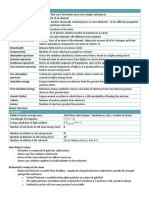0% found this document useful (0 votes)
45 views2 pagesAtomic Structure (One-Page Notes)
The document provides a comprehensive overview of atomic structure, detailing subatomic particles, quantum mechanics, and key theories such as the photoelectric effect and Bohr's model. It covers fundamental concepts including quantum numbers, electron configurations, and the stability of configurations, along with the nature of electromagnetic radiation. Additionally, it discusses atomic variants and historical atomic models, emphasizing the quantized nature of energy and the principles governing atomic behavior.
Uploaded by
liya0antonyCopyright
© © All Rights Reserved
We take content rights seriously. If you suspect this is your content, claim it here.
Available Formats
Download as PDF, TXT or read online on Scribd
0% found this document useful (0 votes)
45 views2 pagesAtomic Structure (One-Page Notes)
The document provides a comprehensive overview of atomic structure, detailing subatomic particles, quantum mechanics, and key theories such as the photoelectric effect and Bohr's model. It covers fundamental concepts including quantum numbers, electron configurations, and the stability of configurations, along with the nature of electromagnetic radiation. Additionally, it discusses atomic variants and historical atomic models, emphasizing the quantized nature of energy and the principles governing atomic behavior.
Uploaded by
liya0antonyCopyright
© © All Rights Reserved
We take content rights seriously. If you suspect this is your content, claim it here.
Available Formats
Download as PDF, TXT or read online on Scribd
/ 2

























































